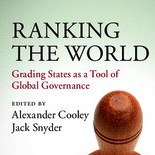(Book Review) How Powerful Are Global Indicators? Statistical indicators are more influential than ever before. The Economist provided one recent overview of the power of indicators in a report entitled “How to lie with indices,” and Alexander Cooley and Jack Snyder give a similar motivation and justification for their edited volume Ranking the World: Grading States as a Tool of Global Governance. There are more numbers and they are having more influence, so we need to get a handle on how they are produced and what kind of power they have. I agree, there is a rise in indicators. Moreover, fueled by big data and the sustainable development goals, the so-called data revolution is finding its feet, so I do not expect it to let up anytime soon.
As one would expect there is now a ballooning literature to match the rise of indicators. Cooley and Snyder’s volume is on trend here, and collects a nice set of contributions, largely originating from international relations scholars working on Eurasia. The early and leading contributions in the literature on indicators emerged from law and anthropology (sometimes cross-disciplinary work), but now political science, and in particular international relations, is following. Economics is as far as I can tell still on the sidelines. Of course, “constructivism” within international relations has a natural comparative advantage in approaching data as social products. On the other hand, economists, statisticians, and political scientists of the positivist mold have a mountain to climb.
I hope there will be a gradual shift in all disciplines towards approaching global indicators critically as “products” rather than the mainstream approach of being uncritical consumers of indicators. All these indicators are entering the realm of “as if” governance. We all know, I hope, that the Freedom House actually does not measure “democracy”; that the consumer price index does not actually measure “inflation”; and that Transparency International does not actually measure “corruption.” We just pretend “as if” they do. We are in deep trouble if we forget that we are making decisions or doing analytic research “as if” these things can actually be counted.
Cooley and Snyder provides a good introduction and conclusion that makes for excellent reading if you want to get an idea of the main research questions and what has been discovered thus far. The collected papers here are thus a really useful report on progress thus far on the topic. The volume makes the point that indicators are powerful, and in doing so, one might say that they have indeed picked the most visible and powerful ones. We are first introduced to the world of the credit-rating agencies by Rawi Abdelal and Mark Blyth, before Mlada Bukovansky treats us to a study of how corruption is measured. Nehal Bhuta provides a rather parallel study of how “state fragility” is quantified. Seva Gunitsky compares different ways to quantify the degree of democracy in a country. And if you did not already question whether such indicators might be the subject of gaming, Sam Schueth provides a study of how Georgia responded to being ranked on the Doing Business Index.
This edited volume is a good place to start if you are looking to read up on some of the numbers literature. It has many strengths, one of them being that it appears quite cohesive as far as edited volumes go. It might have benefited from closer proofreading, and the book is, as one would expect, colored by the fact that this a study of numbers from a group of scholars in international relations largely looking at the world from the point of view of US-Russian and Central Asian relations.
Despite the many publications on this topic, I think there are still many holes in our knowledge. There is a further need for empirical research along the lines of political ethnography of indicators. Particularly there is a knowledge gap concerning the relationship between data and decisions. There is also a surprising gap in knowledge of what makes a good indicator and what does not. The book chiefly presents studies where numbers do matter–such as when Georgia targeted the indicator that measures the ease of doing business. But more often than not evidence, statistics, and indicators are roundly ignored. There are more indicators now than before, but why do some matter and others do not? These are just some of the questions that arise when reading the book. In other words: more research is needed, and this book is a good start if you want to be stimulated.
Reviewer: Morten Jerven
See the original post © H-Diplo/H-Net (Humanities & Social Sciences Online)
Click here for books by PONARS Eurasia members











